Arts & Entertainment Community
Local man helping auction relics from Western Flyer, a boat famously connected to Steinbeck
How much would you pay to own one-of-a-kind pieces of fishing, environmental, scientific and literary history? Could you be an “angel?”
Arts & Entertainment Sponsor
Arts & Entertainment stories are made possible in part by the Gig Harbor Film Festival, a proud sponsor of Gig Harbor Now.
Those are questions inspired by a Wauna man’s quest.
Michael Hemp, a vibrant, engaging and consistently curious 81-year-old whose business card lists him as “Historian, Heritage Marketing & Communications Consultant, Researcher, Archivist, Lecturer, Novelist,” seeks a buyer for a brass steering wheel, a hefty engine shift lever and two gimballed compasses.
The items are original pieces from a 76-foot-long purse seiner fishing boat built in Tacoma 87 years ago. It is similar in design and purpose to hundreds launched there, in Gig Harbor, and in other Northwest boatyards during the 20th century.
One big distinction: All four artifacts once were crucial and original parts of arguably the world’s most famous purse seiner, a title earned because a couple of friends chartered it in Monterey, California, in 1940 for a six-week cruise of research and exploration in Mexico.
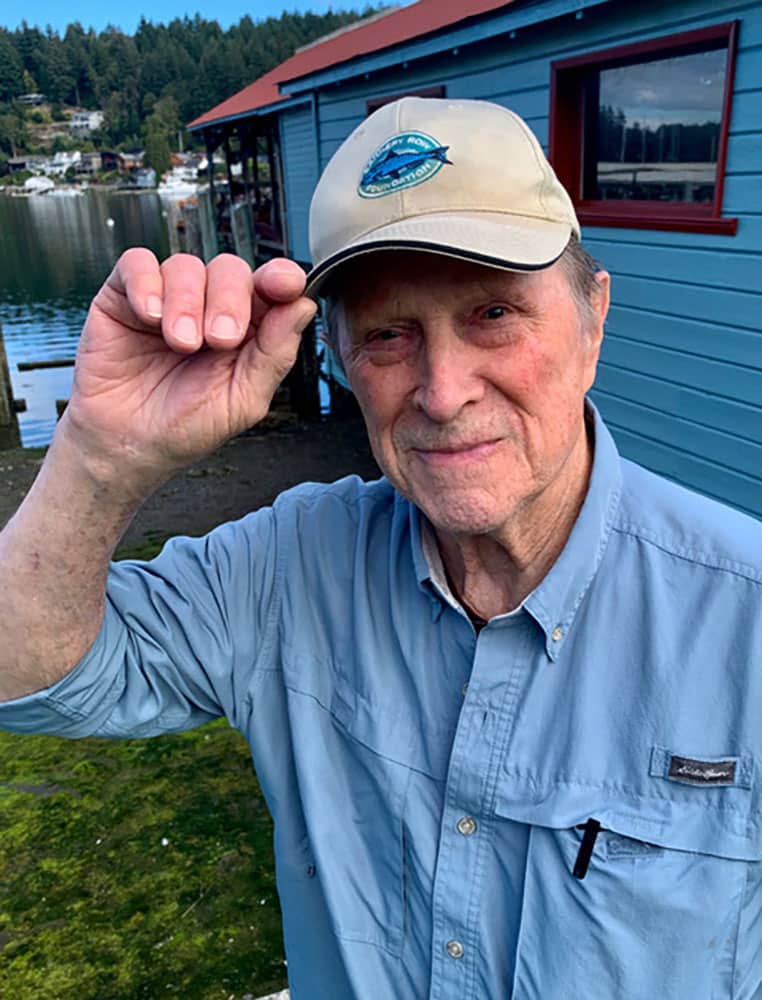
Michael Hemp. Photo by Chapin Day
Steinbeck and the Western Flyer
The friends were novelist John Steinbeck and biologist and writer Ed Ricketts. The name emblazoned on the boat’s bow: Western Flyer. Their hands were among those who turned that wheel and shifted that lever. Their eyes read those compasses.
The friendship has been described by many as a unique blend of commonalities, including powerful intellects focused on marine science, literature, music, philosophy, and a belief in the interrelationship and interdependence of everything in our world and beyond.
Their minds met and explored at intersections of art and science. Reportedly, they also shared a taste for alcohol and good times.
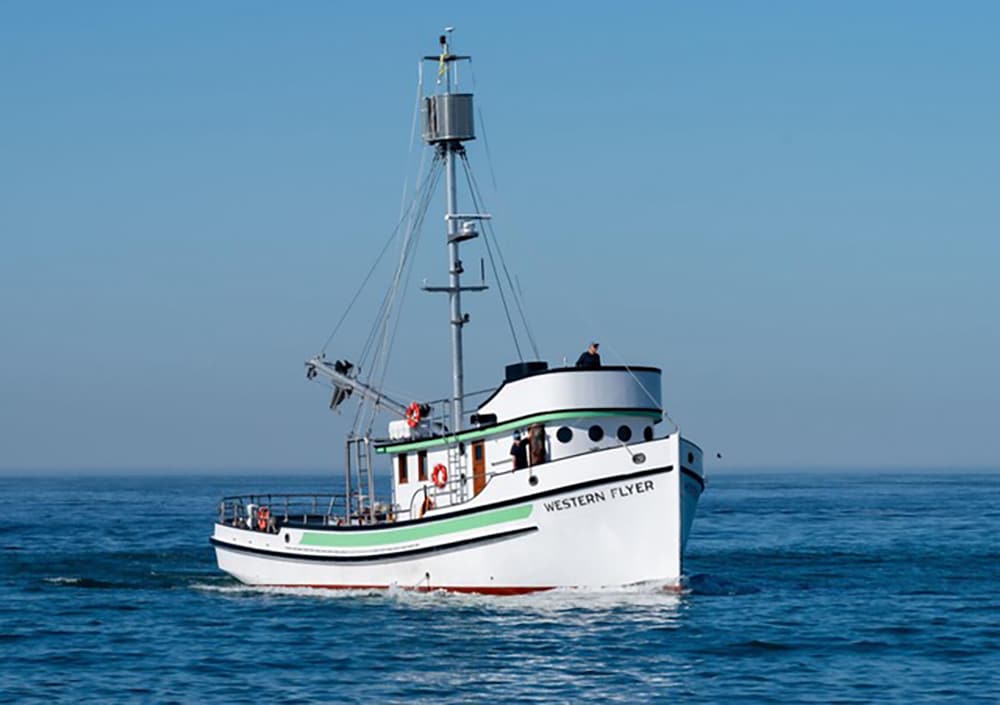
The Western Flyer, which once carried John Steinbeck and Ed Ricketts on a journey around the Gulf of California. Western Flyer Foundation/Kirsten Burroughs.
To Ricketts, owner of a commercial marine lab, the voyage was a continuation of a life exploring tide pools and writing about West Coast marine life. For Steinbeck, the trip offered refuge from a nationwide storm of criticism, controversy, book burnings and other violence stirred by his 1939 novel, “The Grapes of Wrath.”
The pair, already known in their own professional spheres, ensured their boat’s enduring fame, and ultimately its preservation, by jointly writing an account of their voyage. “The Sea of Cortez”, was published in 1941, subtitled “A Leisurely Journey of Travel and Research.”
In a nation distracted by the onset of World War II, the book, now widely considered a pioneering ecological work, drew some academic interest but few sales and relatively little public notice.
In 1951, three years after Ricketts’ death in a car-train collision, greater worldwide and critical acclaim followed when Steinbeck published a revamped and shortened version, “The Log from the Sea of Cortez.”
Tacoma-born boat
Why might Gig Harbor Now readers be particularly intrigued by this background and the resultant array of proffered boat parts? We asked Michael Hemp that question.
Donning his “Heritage Marketing” hat as agent for the owner of the Flyer relics, he cites facts from under his “Historian” hat.
Hemp — who runs a firm called The History Company from his home — notes that Ricketts “must of have at least passed through Gig Harbor” during well-documented visits to Wollochet Bay and vacations along the Hood Canal.
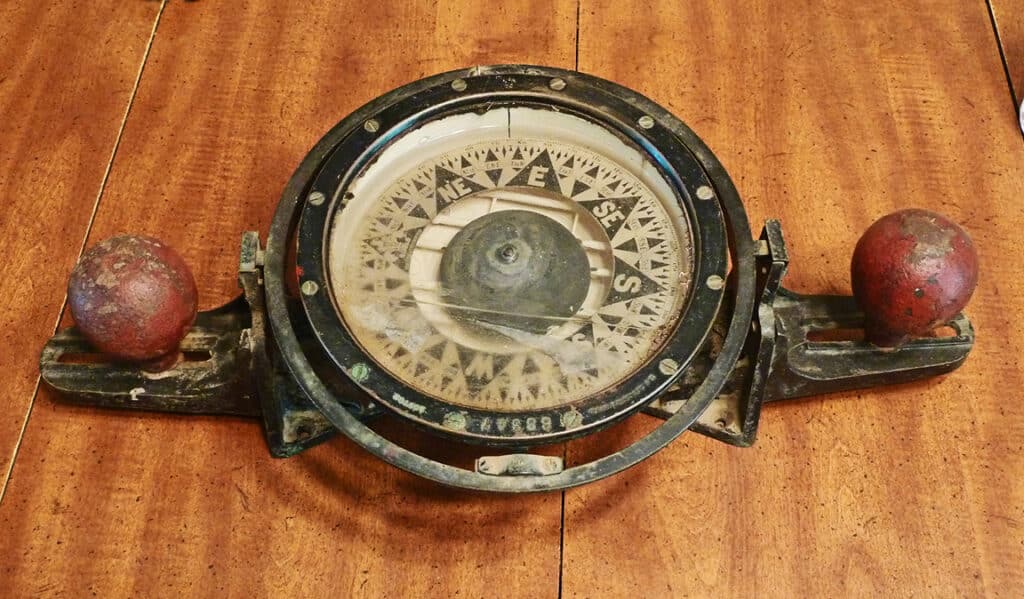
The compass from the Western Flyer. Photo courtesy Michael Hemp
Hemp acknowledged to Gig Harbor Now that he has no proof that Steinbeck or the Western Flyer ever visited Gig Harbor. But he notes that our Puget Sound neighborhood “is part of the basic history triangle” of the vessel.
Aside from its brief but famous expedition to what we now call the Gulf of California, it operated most of its productive fishery lifetime in waters framed by Monterey Bay, Puget Sound, and the Gulf of Alaska.
Furthermore, as Hemp and other historians note, the boat was born in Tacoma, spent years home-ported in Seattle and other Puget Sound and Alaskan harbors, and nearly died by bursting hull planks and sinking twice (once in 2012 and again in 2013) while moored to pilings and neglected near Anacortes. After six months sitting on the bottom in the Swinomish Channel, the bedraggled, broken craft was re-floated and towed to a Port Townsend shipyard.
A humble history
Western Flyer had been built at the now-defunct Western Boat Building Company in Tacoma. Soon after its 1937 launching, it set course for the then-lucrative California sardine trade in Monterey. In the wake of that fishery’s collapse in the late 1940s, the Flyer, like many others of its ilk, scrambled north.
She would spend the rest of her working days toiling for a stream of owners in a succession of ports within a range from Washington to the Aleutians, seeking a variety of prey. She was re-rigged at times as a trawler, a crabber, or as a tender transporting other boats’ catches to canneries.
In 1970, one owner — either indifferent to, unaware of, or unimpressed by the Western Flyer’s literary and scientific resume — changed the boat’s name to Gemini, reportedly to honor a NASA space program, not twins from Greek mythology.
In a far-flung fleet, fame can be fleeting. For most people, under its new name, Western Flyer faded into a fog of forgotten history.
‘What a beautiful boat’
But five years later, as Gemini cruised into harbor at Homer, Alaska, it caught the eye of young fisherman Dennis Fry. Totally oblivious to its heritage, he remembers exclaiming, “Wow, what a beautiful boat.”
A year or so later, Fry’s family bought Gemini from its owner, a fish cannery. The Frys updated, adapted and improved their purchase, including replacing controls on the flybridge cabin-top steering station — the aforementioned wheel, shift lever and compass — plus the main deck wheelhouse compass.
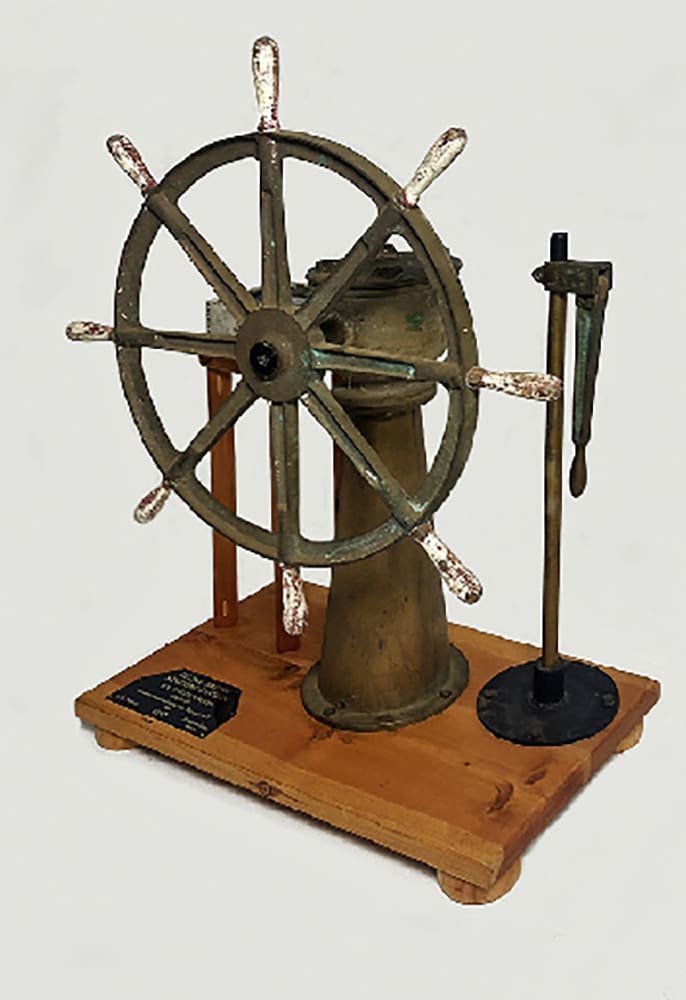
Dennis Fry removed the wheel from the Western Flyer in the late 1970s. The wheel and other items salvaged from the Flyer are now slated to be offered at auction. Photo courtesy of The History Company
He added the removed items to a scrap pile at the Fry home. Eventually, Dennis Fry scavenged and set them aside.
In 1990, Dennis ended his fishing career, moved with his wife from Alaska to northern California’s Shasta County, and became a log-haul trucker. He brought the four “Gemini”relics along with him and stored them, he says, still unaware of any extraordinary value they might have.
About 25 years later, Dennis recalls, that changed. Michael Hemp appeared at his doorstep.
When Hemp settled in Monterey County in 1979, he admits he carried only scant knowledge of John Steinbeck’s works or Cannery Row’s history. An eke-out-a living job writing for a fledgling local magazine soon helped put him in touch with the local lore and culture.
Cannery Row Foundation
He dove deep. Somewhat startled by the dearth of a reliable history of the rise and fall of the Monterey fishing industry, in 1983 Hemp founded a now inactive nonprofit called the Cannery Row Foundation. He played a leading role in it until shortly after moving to Wauna seven years ago.
The foundation’s goal: “To preserve the historical and literary resources of Cannery Row … and to research, interpret, educate, disseminate, and celebrate the unique multi-cultural essence of Cannery Row’s historic, literary, cultural and ecological legacies.”
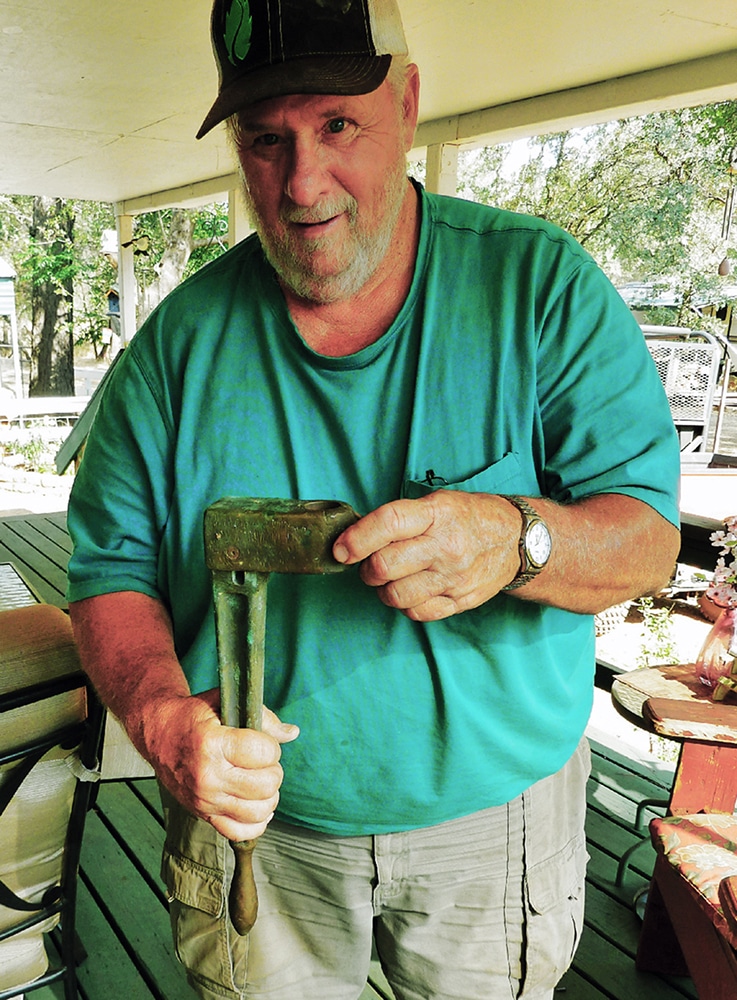
Dennis Fry with the engine shift lever he pulled off of the Gemini, not realizing the boat was famous under its previous name. Photo courtesy Michael Hemp
By 1986, Hemp had written and published the first edition what has become an authoritative, heavily illustrated history, “Cannery Row: The History of John Steinbeck’s Old Ocean View Avenue and Its Connections to the Pacific Northwest.” (Its updated fifth edition was copywrited in 2022.)
Of course, while tracing Cannery Row history, Hemp inevitably encountered and delved into tales of the Western Flyer, at that time considered — by anyone who cared — lost or MIA .
The boat re-emerged from obscurity in 1986 after Bob Enea, an historian and nephew of a crew member on the Western Flyer during its Sea of Cortez journey, tracked it down. He had realized that the vessel’s federally-assigned radio call sign did not change when it was renamed “Gemini.”
Thus armed, Enea found the boat moored to pilings in the Swinomish Channel near Anacortes. He shared the news with Hemp and others.
Saving the Western Flyer
In the ensuing years, a restless tide of earnest, well-intended but short-funded efforts to save the vessel failed. Its then owner, later purchasers, the Cannery Row Foundation, and Hemp all tried to promote restoration of the worn and outdated boat, which at one point sold for just $25,000.
Some, like Hemp, wanted to see it acquired and exhibited at an appropriate museum. One developer bought the boat with a notion to launch it in an indoor moat as part of a restaurant. That plan, and those of other dreamers, faltered.
The former Western Flyer fell into other hands and, eventually, twice into the muck of the channel. Hemp says the Coast Guard threatened to seize and destroy it as a threat to navigation and the environment.
After the second sinking, it remained submerged for months, collecting an array of clinging and transient sea life that would have delighted tide pool explorer Ricketts.
All of that was on display in 2013, when its then owner re-floated the hulk and had it towed to and hauled out at Port Townsend.
Within two years, an “angel” would appear.
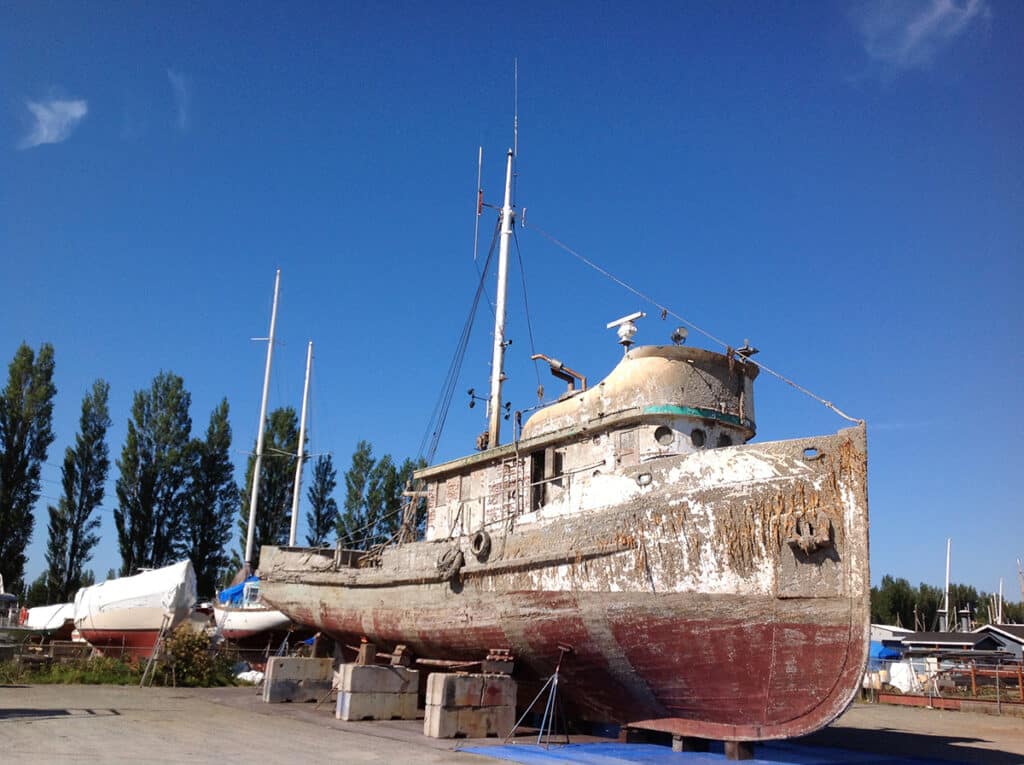
The mud-covered Western Flyer after it had been hauled out. Photo courtesy Anne Shaffer
‘Personification of a man’s soul’
In museum management and antique appraisal parlance, an “angel” is a well-heeled, well-motivated donor, buyer or seller.
John Gregg, now 64, more than qualified.
A marine geologist and engineer with an innovative bent, Gregg had amassed a considerable fortune by the time he was in his mid-50s. Among his credits: Inventing a self-cleaning bit for underwater drills, a money- and time-saving boon for oil and other marine industries.
In effect, he credits Steinbeck and Ricketts for inspiring his maritime career and cementing his interest in the Western Flyer.
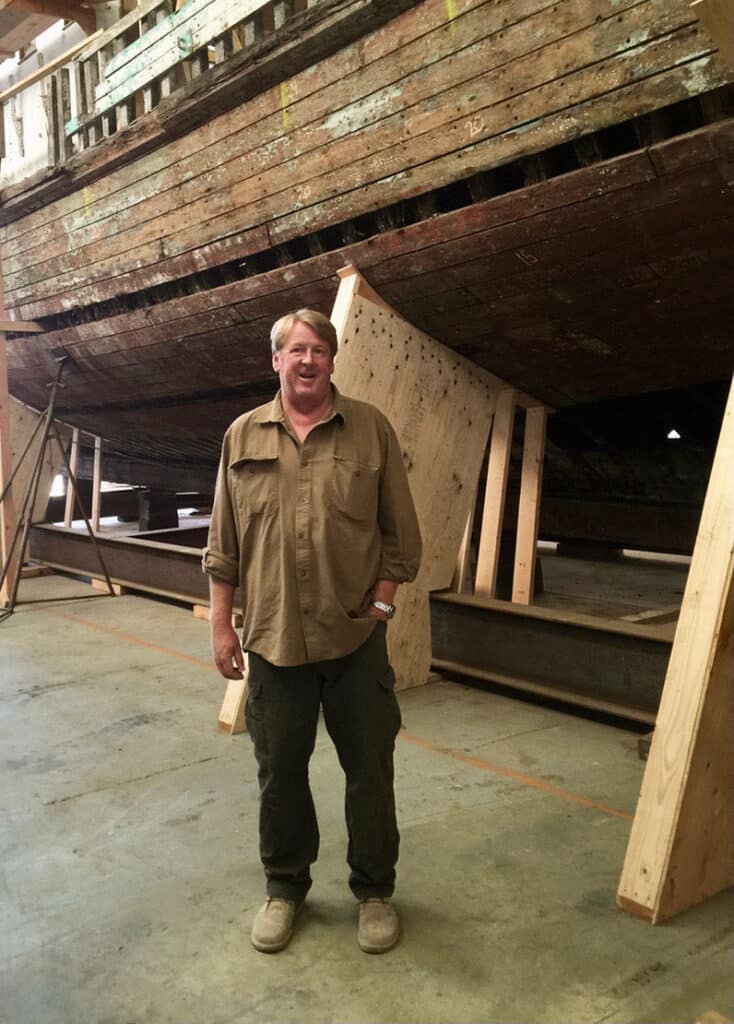
John Gregg at Port Townsend in 2015. Photo courtesy Michael Kenneth Hemp
He has written in a brief memoir essay that, as a 10-year-old boy in rural Georgia, he hurriedly “grabbed a book from a bookmobile by mistake and was forever changed by it.”
The book: The 1951 version of “The Log from The Sea of Cortez.”
“It sounded adventurous. And it was.”
“I realized then,” he wrote in a 2020 journal article, “that a person could, with their friends, go to a remote place and do real science while having breathless adventure.”
As many do, he quotes Steinbeck’s words: “Of all man’s tools, the boat is a personification of a man’s soul.”
Whatever his motivation, Gregg took notice and action when he learned in 2015 that Western Flyer was “on the hard,” sitting idle ashore on boatyard blocks in Port Townsend.
He wanted it.
In 2015, after facing stubborn reluctance during routine negotiations with the boat’s then owner, he made an astonishing offer for the rotten-hulled boat that had sold for $25,000 in the not too distant past.
One million dollars.
Sold!
Back on the water
In 2023, eight years and a reported $7 million later, the Western Flyer — re-named, re-built, re-powered, re-stored and re-purposed — finally left Port Townsend’s Shipwright’s Co-Op for a triumphant and celebrated return to Monterey.
Gregg has turned ownership of the boat, now hybrid electric-driven and lab-equipped, to the nonprofit Western Flyer Foundation, based in Moss Landing, California, not far from Monterey.
The foundation’s stated mission: “To stir curiosity through marine research, education, and a blend of science and art inspired by John Steinbeck, Ed Ricketts, and their journey on the Western Flyer.”
Shortly after the boat’s arrival in Monterey late last year, a CBS television reporter asked Gregg about his costly commitment, which had been supplemented by grants and other donations.
“I thought I could fix it and bring it back to life again,” Gregg replied. “And I didn’t see another scenario where it was going to survive.”
The reporter noted Gregg’s tendency to dream big.
“Everything good starts with someone’s dream,” Gregg said, “and the best things are when multiple people have the same dream.”
Angel.
Western Flyer treasures at auction
Is there another angel out there intrigued by trucker Fry’s Western Flyer gear? A museum? A library? A university? Maybe a private collector who wants to see the items adorning his or her den or office?
“It only takes one,” Michael Hemp says hopefully.
He now finds himself the fisherman, doing what he loves — tracing history — while also working for a share of the catch if he reels in a buyer.
Late last month, he baited the hook by sending out an elaborate illustrated press release to 44 news organizations, big ones like the New York Times and the Washington Post and less sizable ones in maritime communities.
Gig Harbor Now made the list.
Headline on the release: “John Steinbeck’s 1940 Chartered Western Flyer Navigational Artifacts Are Headed to Public Auction.”
Except for calls from this reporter, the threat of a competitive bidding battle has yet to stimulate much response.
Despite the widespread silence, Hemp says he continues “working on” picking a suitable auction house and has at least one good prospect in hand.
Appropriately cagey about discussing pricing strategies, he says he expects to use as a basis price the figure arrived at in 2017 by a maritime antiques appraiser: $68,732. In 2022, the same appraiser issued an addendum raising the the figure to $75,638.
That totaled more than five times the $15,000 that “angel” Gregg offered trucker Fry for the items in 2015, shortly after Gregg’s million-dollar purchase of “Western Flyer.” Fry flatly rejected that offer.
Western Flyer relics
In a recent phone call with Gig Harbor Now, Fry, a genial fellow who keeps the relics in his home, said he thinks he should “at least get the appraisal price.”
Fry confirmed that he has a contract with Hemp to represent him in any sale. He added that he and his wife want to sell now “to help out financially” as he copes with lingering affects of a 2019 truck accident.
Fry says he first encountered Hemp in 2015 when Hemp called and then came to his home.
Hemp says a tip about the existence of the relics prompted that visit. At the time, he was allied with Gregg in the effort to save and revive Western Flyer. He became the go-between linking Fry and Gregg in the failed 2015 negotiations but has remained in touch with Fry ever since.
In 2017, Hemp arranged for appraisal of Fry’s collected goods.
Appraising history
The appraiser, Roger Ottenbach, has been in the marine antiques business for more than four decades, first in Bellevue, then Seattle, and now Port Orchard, where he lives.
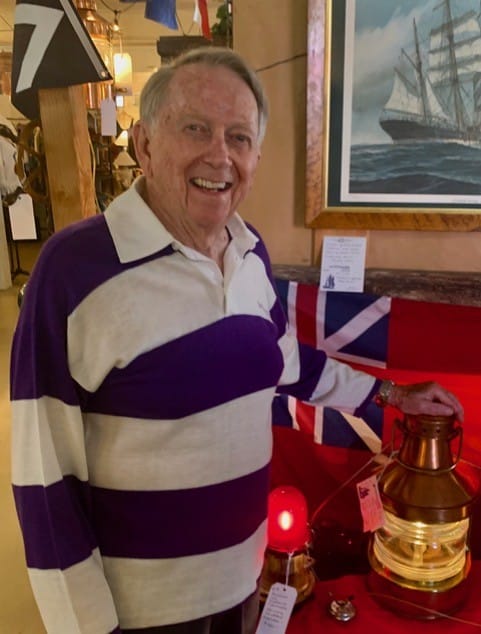
Roger Ottenbach at his Orchard Park business. Photo: Chapin Day
He made his appraisals of Fry’s relics without personally inspecting them. Instead, he studied detailed high-resolution photographs.
In a recent conversation, he told Gig Harbor Now his valuation was based on viewing the photos, researching the authenticity and ownership of the items, their historical and literary interest, and checking current and past pricing of comparable objects.
Key factors boosting the estimates he made, he says, included links to Steinbeck, Ricketts, and the Western Flyer, plus heightening local interest in Puget Sound in 2017 and 2022 because of abundant publicity stirred by the restoration project in Port Townsend.
He called the Fry relics “special items” and “irreplaceable pieces,” justifying his estimates.
He now says he would have to conduct a new full appraisal to determine their present value because today is a different market in a different time. Values “can go up,” he said. However, he issued a general caution, “As years go by the value of antiques can decrease.”
The true dollar value of anything, he said, “depends on two people agreeing, a buyer and a seller.”
Will someone take a flyer?
Ending our recent phone call with relic-owner Fry, Gig Harbor Now asked, “What will happen to your items if they don’t sell?”
“I don’t know,” he said chuckling quietly. “Guess I’ll keep ’em and hand ’em down to my grandkids.”
Both Fry and Hemp say they hope the items will end up where the public can enjoy them.
In a wishful moment, Hemp said that perhaps the Gregg-supported Western Flyer Foundation “will have someone bidding.”
Sherry Flumerfelt, executive director of the foundation, told Gig Harbor Now that the organization would like to have Fry’s collection but “the price is out of our range.” Later she added: “Sure would be nice if someone donated it.”
(Reporter’s note: In addition to in-person and telephone interviews and on-line resources, this article draws on original research by many others, notably in the book “The Western Flyer,” by Kevin M. Bailey, and in “Cannery Row, The History of John Steinbeck’s Old Ocean Avenue and Its Connections to the Northwest” by Michael Kenneth Hemp.)


